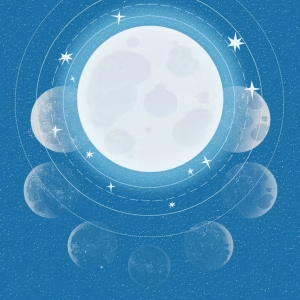The moon and planets september 2025 make for an exceptionally busy and spectacular sky month. The absolute highlight is the night of Sunday, Sept. 7: a full Corn Moon coinciding with a total lunar eclipse. This is followed by several special encounters with Saturn, Jupiter and Venus. So it is a month in which you can observe something special in the sky almost every week.
👉 Want to know more about the full moon and eclipse? Read our separate blog: Full moon September 2025.
The moon in September
The moon plays a starring role this month. A brief summary of the key moments:
- September 7: Full Corn Moon + total lunar eclipse.
- September 9: Moon close to Saturn.
- Sept. 16: Moon at Jupiter.
- September 19: Moon near Venus, in parts of Europe even a occultation (this includes Venus passing the moon)
For those interested in learning more about the eclipse and the significance of the Wheat Moon, please see our separate blog. In this article, we zoom in mainly on planetary positions and conjunctions with the moon.
Saturn in opposition - Sept. 21, 2025
The absolute planetary highlight of September is the opposition of Saturn. Opposition means that Saturn is exactly opposite the sun: the planet rises at sunset and sets at sunrise. So you can admire Saturn all night long.
- Date: September 21, 2025.
- Brightness: around magnitude 0.5, remarkably bright.
- Location: in the constellation Aquarius, southern sky.
- Best time: around midnight, Saturn is highest in the sky.
What makes opposition special? Because the planet is relatively close to Earth, its rings and moons appear larger and brighter. With a simple telescope, you can already see the iconic ring structure.
👉 In this blog we explained very quickly which telescope is best suited for Saturn.
Jupiter and the moon - Sept. 16
In the middle of the month, the moon is close to Jupiter, the largest planet in our solar system. It is a beautiful sight: the bright gas giant with the moon next to it.
- Date: September 16, 2025.
- Time: after midnight, over the eastern sky.
- What you can see: next to Jupiter, with a small telescope you can already see the four largest moons: Io, Europa, Ganymede and Callisto. They look like little points of light lined up neatly.
With a larger telescope, such as a Dobson of 150 mm or 200 mm, you can see Jupiter's cloud bands: dark and light stripes that mark the planet's atmosphere. On good nights, you can even spot the Great Red Spot, a storm that has been ‘living’ on the planet for centuries.
👉 Observation Tip: use a moon and planet filter. This filter increases contrast and makes details such as cloud bands and moons much more visible. Also in this blog, we explain the best way to view Jupiter through a telescope, and what it looks like!
Venus and the moon - Sept. 19
In the early morning of Sept. 19, the moon slides close past Venus, the brightest object in the sky after the moon itself.
- Date: September 19, 2025.
- Time: just before sunrise, low on the eastern horizon.
- Special: in southern Europe, a occultation place, with the moon temporarily completely covering Venus. In the Netherlands and Belgium, we see them just next to each other.
This conjunction is especially photogenic. A simple smartphone mount on a telescope or tripod is enough to capture a beautiful picture.
Other planets in September
Besides the big three, there are other planets to see, although it requires a bit more effort:
- Mars: still too dim and low in the morning, details are barely visible.
- Mercury: is too close to the sun and is virtually invisible this month.
- Uranus: visible at night with medium-sized telescopes. A Dobson 200 mm or a smaller refractor shows a small greenish disc.
- Neptune: visible only with large telescopes under dark skies.
Tips for observation and photography
In September, the nights are longer, giving you plenty of time to view the sky. Some practical tips:
- For the eclipse and faint planets: look for a place with as little light pollution as possible. The blood moon and distant planets such as Uranus and Neptune are then more visible.
- For bright objects: the moon, Jupiter, Saturn and Venus can also be seen just fine from the city. Here light pollution hardly plays a role.
- Use a stable tripod: vibrations are disastrous at high magnifications.
- Schedule your session: apps like Stellarium or SkySafari help to know where planets are.
- Photography: use a maksutov telescope And a DSLR with tracking mount for longer exposures.
Why is September 2025 so special?
Not every month is so rife with such highlights. September 2025 combines a blood moon, an opposition of Saturn and several notable conjunctions. That makes this the month for anyone who wants to do more than just take a quick look up ... although that's fine too, of course!
For beginners, it is an ideal opportunity to get started with a simple Dobson. For advanced observers and photographers, the month provides the perfect opportunity to test their setup and capture spectacular images.
Conclusion
The moon and planets september 2025 bring a month full of highlights. From the blood-red Corn Moon and lunar eclipse on Sept. 7 to Saturn's opposition on Sept. 21, there is something special for every star lover to see. Add in the close conjunctions with Jupiter and Venus, and you have one of the most complete sky months of this decade.







